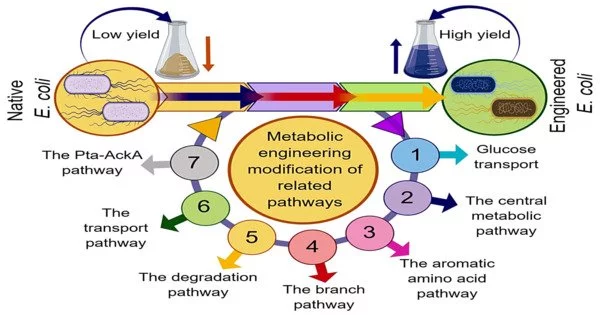Metabolic engineering is a branch of biotechnology that entails optimizing and manipulating cellular metabolic pathways in order to increase the production of specific compounds or the performance of desired functions within an organism. It is the practice of improving genetic and regulatory processes within cells in order to increase the cell’s production of a specific substance. These are chemical networks that use a series of biochemical reactions and enzymes to convert raw materials into molecules required for cell survival.
Metabolic engineering aims to mathematically model these networks, calculate a yield of useful products, and identify parts of the network that limit product production. The ultimate goal is to create or re-create metabolic pathways in living cells in order to achieve better or novel biochemical processes.
Key aspects of metabolic engineering include:
- Understanding Metabolic Pathways: Identify and comprehend the metabolic pathways that are relevant to the production of the desired compound within a cell or organism.
- Genetic Modification: Modify an organism’s genetic material to add new genes, delete existing ones, or change gene expression levels. Typically, this is accomplished using genetic engineering techniques such as gene knockout, gene insertion, or gene silencing.
- Optimization of Enzyme Activities: To increase the production of desired metabolites, increase the activity of enzymes involved in the target metabolic pathway. This can be accomplished by engineering enzymes or manipulating factors that affect enzyme activity.
- Pathway Balancing: Make certain that the flux of metabolites through the engineered pathway is balanced to avoid the accumulation of intermediates that could be toxic to the host organism.
- Strain Improvement: Select or engineer microbial strains with desirable characteristics such as high growth rates, substrate utilization efficiency, and resistance to harsh environmental conditions.
Applications
Genetic engineering techniques can then be used to modify the network in order to relieve these constraints. Once again this modified network can be modeled to calculate the new product yield. It has diverse applications, including the production of biofuels, pharmaceuticals, chemicals, and industrial enzymes. It can also be applied to improve the nutritional content of crops or enhance the synthesis of valuable natural products.
The ultimate goal of metabolic engineering is to be able to use these organisms on an industrial scale to produce valuable substances in a cost-effective manner. Beer, wine, cheese, pharmaceuticals, and other biotechnology products are current examples. Some common metabolic engineering strategies include (1) overexpression of the gene encoding the biosynthetic pathway’s rate-limiting enzyme, (2) blocking competing metabolic pathways, (3) heterologous gene expression, and (4) enzyme engineering.
Metabolic engineering has made significant advances in the development of environmentally friendly and economically viable processes for the manufacture of various compounds. The complexity of cellular metabolism, the possibility of unintended consequences in genetic modifications, and the need for efficient scale-up and commercialization of engineered strains are all challenges that remain. Advances in synthetic biology, genome editing technologies, and computational tools continue to drive progress in the field.
















